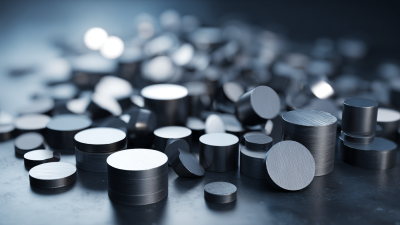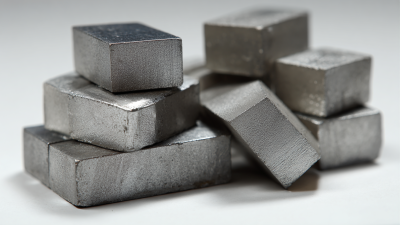Leave Your Message
The advancement of modern technology is increasingly influenced by materials that offer superior performance and efficiency, among which Silicon Carbide Ceramic stands out. According to a recent market report by Research and Markets, the global silicon carbide market is projected to reach USD 6.02 billion by 2026, growing at a CAGR of 16.6% due to its diverse applications in industries such as electronics, automotive, and aerospace. Silicon Carbide Ceramic exhibits exceptional thermal conductivity, high chemical resistance, and mechanical strength, which makes it a preferred choice for components that operate under extreme conditions. Furthermore, its ability to enhance the efficiency of power electronics is driving its adoption in electric vehicles and renewable energy systems, where performance and reliability are paramount. This exploration will delve into the multifaceted advantages of Silicon Carbide Ceramic and its pivotal role in shaping the future of technology.

Silicon carbide (SiC) ceramic is a remarkable material that possesses unique properties making it suitable for modern technological applications. One of its key characteristics is high thermal conductivity, a feature that is especially valuable in industries like renewable energy and aerospace. Recent studies have highlighted the influence of SiC addition on the microstructure and mechanical properties of boron carbide ceramics. This interaction enhances the compressive strength and overall performance, demonstrating the potential for tailored applications in high-stress environments.
The toughness of SiC is another pivotal property, particularly in brittle materials where fracture resistance is critical. Advanced research employs atomic-resolution studies to investigate fracture mechanisms in SiC, which elucidates how its structural integrity can be optimized for extreme conditions. Moreover, the environmental resilience of SiC-based ceramic matrix composites is crucial for aerospace applications, where understanding the interfacial properties can lead to improved durability and reliability in demanding operational settings. Thus, the exploration of silicon carbide ceramics not only sheds light on their fundamental properties but also paves the way for innovative uses in cutting-edge technology.
| Property | Description | Benefits |
|---|---|---|
| High Hardness | Silicon carbide ceramic exhibits exceptional hardness, making it resistant to wear and erosion. | Longer lifespan of components; reduced maintenance costs. |
| High Thermal Conductivity | This material can efficiently conduct heat, which is crucial for thermal management in devices. | Enhances performance in high-temperature applications; reduces risk of overheating. |
| Chemical Resistance | Silicon carbide ceramic is highly resistant to chemical attack, including acids and alkalis. | Increased durability in harsh environments; extended service life. |
| Low Thermal Expansion | The material exhibits minimal expansion when heated, which helps maintain dimensional stability. | Improves accuracy and reliability in precision applications. |
| Electrical Insulation | Silicon carbide ceramic is an excellent insulator, allowing for various electronic applications. | Prevents electrical failures; enables miniaturization in electronic devices. |
Silicon carbide (SiC) ceramic is increasingly recognized for its exceptional properties that enhance energy efficiency in various technological applications. As industries strive to reduce carbon footprints and enhance performance, SiC has emerged as a preferred material in energy-intensive sectors. Its high thermal conductivity and wide bandgap are key attributes that enable efficient power conversion, making it vital for applications in the semiconductor and power generation industries.
Recent market analyses project substantial growth in the silicon carbide market, particularly in the aerospace and automotive sectors. The global SiC market size is expected to expand significantly by 2032, driven by demands for more efficient power systems and improved durability in extreme environments. Notably, the availability of various product forms, including single crystal and polycrystalline SiC, provides flexible solutions tailored to specific requirements across industries. Reports indicate that the adoption of SiC in energy efficiency applications is forecasted to boost performance metrics by allowing devices to operate at higher temperatures and voltages, thus reducing energy losses and enhancing overall system efficiency.
Silicon carbide (SiC) has emerged as a game-changing material in the electronics and power devices sector, primarily due to its outstanding thermal conductivity, high breakdown electric field strength, and superior mechanical properties. The global market for silicon carbide is projected to reach approximately $5 billion by 2025, growing at a compound annual growth rate (CAGR) of around 20% from 2020. This rapid expansion is driven by the increasing demand for energy-efficient devices and the growing adoption of electric vehicles (EVs).
One of the key applications of SiC is in power electronics, where it is utilized in devices such as MOSFETs and diodes. SiC components can operate at higher voltages, frequencies, and temperatures compared to traditional silicon solutions, leading to significant improvements in efficiency and performance in power converters. According to a recent report by Grand View Research, the SiC power semiconductor market is expected to witness significant growth due to the rising need for advanced power conversion systems in renewable energy and electrification.
Tip: When designing systems with SiC components, ensure that the cooling mechanisms are well-planned to leverage SiC's thermal properties fully, as effective heat dissipation can further enhance performance and longevity.
In addition to power applications, SiC is increasingly used in high-frequency and high-temperature electronic devices. For instance, RF devices made from silicon carbide can operate at frequencies up to 200 GHz, which is critical for communication technologies such as 5G. With the continuous evolution of telecommunication requirements, the demand for SiC in this sector is set to soar.
Tip: Consider investing in SiC technologies early, as the increasing penetration of 5G and other advanced communication networks could lead to substantial competitive advantages in the market.
Silicon carbide (SiC) has emerged as a formidable competitor to traditional materials in various modern technological applications. Unlike conventional materials such as silicon, ceramics, and metals, silicon carbide offers superior thermal conductivity, allowing devices to operate at much higher temperatures without performance degradation. This capability is particularly advantageous in power electronics, where high efficiency and thermal management are crucial. In comparison, traditional materials often suffer from limitations in heat resistance and electrical efficiency, resulting in increased energy losses and compromised device longevity.
Furthermore, the mechanical properties of silicon carbide set it apart from its traditional counterparts. SiC exhibits exceptional hardness and chemical stability, making it an ideal choice for abrasive and wear-resistant applications. In contrast, many traditional materials may lack the durability required for demanding environments, leading to frequent replacements and higher long-term costs. This comparative analysis reveals that silicon carbide not only enhances performance but also promotes sustainability through reduced material waste and increased device lifespan, reinforcing its position as a leading material in the evolving technological landscape.

Silicon carbide (SiC) has emerged as a pivotal material in the realm of third-generation semiconductors, presenting unparalleled advantages for modern technology. Its exceptional physical properties, including higher thermal conductivity and superior breakdown field strength, have catalyzed its adoption in various sectors such as electric vehicles, photovoltaic energy storage, and 5G telecommunications. As industries pivot towards sustainability and efficiency, SiC stands out by enabling devices that are not only more powerful but also more energy-efficient.

Future trends indicate that we are on the brink of a significant technological evolution in SiC applications. With projections highlighting its increasing vital role in the automotive sector, the rise of electric vehicles will drive substantial advancements in SiC technology. Increased innovation in crystal growth and processing techniques is essential, fostering the development of cost-effective SiC devices that can be mass-produced.
Tips: As you explore Silicon carbide technologies, consider keeping abreast of the latest industry events and conferences focusing on SiC developments. Engaging with experts and participating in discussions can provide valuable insights into upcoming trends and applications. Additionally, look into environmental impacts and sustainability aspects of SiC production, which are becoming increasingly important in industry evaluations.






